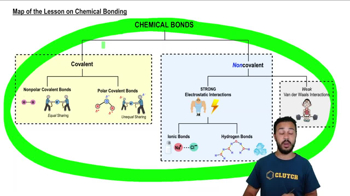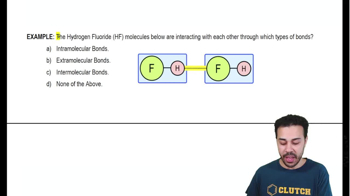2. Chemistry
Introduction to Chemical Bonding
2. Chemistry
Introduction to Chemical Bonding
Additional 3 creators.
Learn with other creators
Showing 6 of 6 videos
Practice this topic
- Open Question
Appropriately label all of the chemical bonds in this image as either intramolecular or intermolecular.
2206views139rank - Multiple Choice
Map of the Lesson on Chemical Bonding
According to the map above, which of the following are types of covalent bonds?
5659views72rank - Multiple ChoiceHow would you respond to this reasoning? Oxygen is not a greenhouse gas; therefore, gases containing oxygen—such as ozone, nitrous oxide, and carbon dioxide—are not greenhouse gases either.4095views
- Multiple ChoiceAn atom that normally has __________ in its outer shell would not tend to form chemical bonds with other atoms.1545views1rank
- Multiple ChoiceThe chemical characteristics or reactivity of an element depend mostly on the __________.2188views
- Textbook QuestionWhat are the defining characteristics of a condensation reaction?a. Two monomers are covalently bonded together and a water molecule is produced.b. Two monomers are covalently bonded together and a water molecule is used up.c. A polymer is broken down into monomers and a water molecule is produced.d. A polymer is broken down into monomers and a water molecule is used up.2721views
- Textbook Question
What are the defining characteristics of a condensation reaction?
a. Two monomers are covalently bonded together and a water molecule is produced.
b. Two monomers are covalently bonded together and a water molecule is used up.
c. A polymer is broken down into monomers and a water molecule is produced.
d. A polymer is broken down into monomers and a water molecule is used up.
1564views - Textbook Question
What is chemically nonsensical about this structure?
1348views










